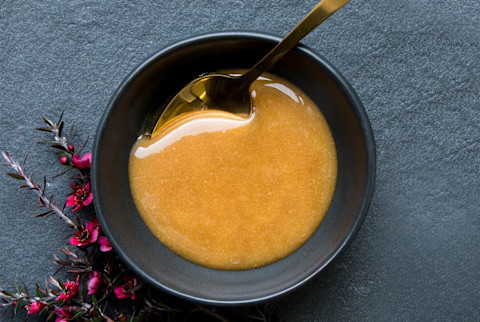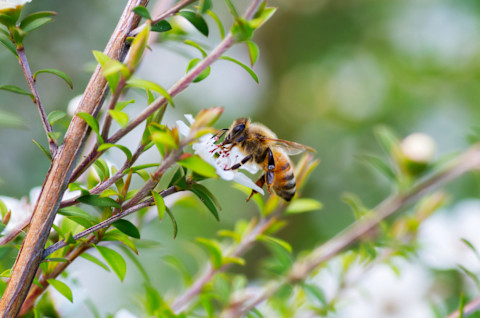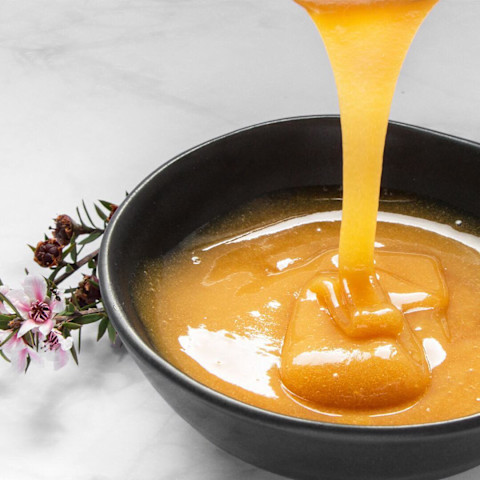
Whether you’re new to natural beauty or have been eschewing parabens for the last decade, investing in a high-quality Manuka honey like Comvita is always a good idea. Aside from its numerous benefits, genuine Manuka honey contains active compounds that are healing, hydrating, and brightening—all the things your skin wants!
Not enough to convince you? Here’s what else you should know:
1. Manuka honey is nature's skin care cure-all.
It’s true, nature made a perfect skin care product that’s gentle enough to use every day. Manuka honey is different from other honeys1—it’s typically more powerful. Authentic Manuka honey comes from the nectar of the Manuka flower, which is native to New Zealand. The Manuka flower's nectar has been shown to have significantly more antibacterial activity levels than other nectars, making it an increasingly popular natural skincare solution.
2. Why Manuka's UMF factor is so important.

UMF stands for Unique Manuka Factor and is New Zealand’s way of grading each jar’s concentration of key Manuka markers, the compounds that measure the proportion of Manuka nectar. Not all jars of Manuka honey are the same. The higher the UMF, the higher the potency of the honey. When investing in honey for its functional properties, whether it’s skin care or not, choosing a certified UMF Manuka honey is recommended.
3. Have your face mask and eat it, too.
Because UMF Manuka honey is chock-full of plant phenols2, it can brighten and repair the skin. You can use it as a cleanser, mask, and spot treatment. When using as a cleanser, drop a dime-size dollop in your palm and emulsify it with warm water before massaging into the skin—this can help keep acne-causing bacteria3 at bay.
As a spot treatment, apply it at night on scars and acne to help reduce dark spots and inflammation. One woman used it to heal her cystic acne, for example, when using it as an overnight treatment. And as a mask, Manuka honey can reduce redness2, boost hydration, and help fight breakouts. The best part? Enjoy indulging in this sweet, multitasking, and effective skin and health booster—beauty from the inside, out.
Here's how to make the most of your Manuka honey mask.

Using Manuka honey as a face mask treatment is one of the best ways to turn up the dial on your skin care routine. But there’s an art to perfecting the DIY Manuka honey mask. Here are some pro tips:
- Create your own "mask kit." This includes a T-shirt that you don’t mind getting wet, a hair clip, a face masking headband, and a hand towel. If you want even more spa vibes, start diffusing your favorite essential oil. Pull or clip your hair back and put on a circular headband if you have one to keep baby hairs away from your face. Grab a small hand towel to catch the drips—getting honey on your floor, in your hair, or elsewhere is inevitable if you don’t prep properly!
- Steam your face. This will prime your face for the mask and help increase the benefits. Set a pot of water to boil, turn it off, let it cool for a few minutes, and steam your face over it for 5 to 10 minutes before you apply the mask. Alternatively, take a hot shower to open your pores.
- Let the mask sit for about 20 minutes (and resist the urge to eat it). Take a tablespoon of honey and apply it to your face using your fingertips. If the jar gets stuck while you’re opening, run it under hot water. This will also loosen the honey, which makes it a bit easier to work with. Because it’s food grade, you can even put a thin layer on your lips. It’ll smell pretty great; we won’t tell if you take a little taste!
- Rinse with warm water, pat dry, and then rinse with cool water. Being mindful of the water temperature will help you work with the texture of the honey and make the whole process more efficient. It’s important to use warm water to rinse—it’ll melt away and won’t get stuck on your face. Rinsing with cool water seals in moisture
